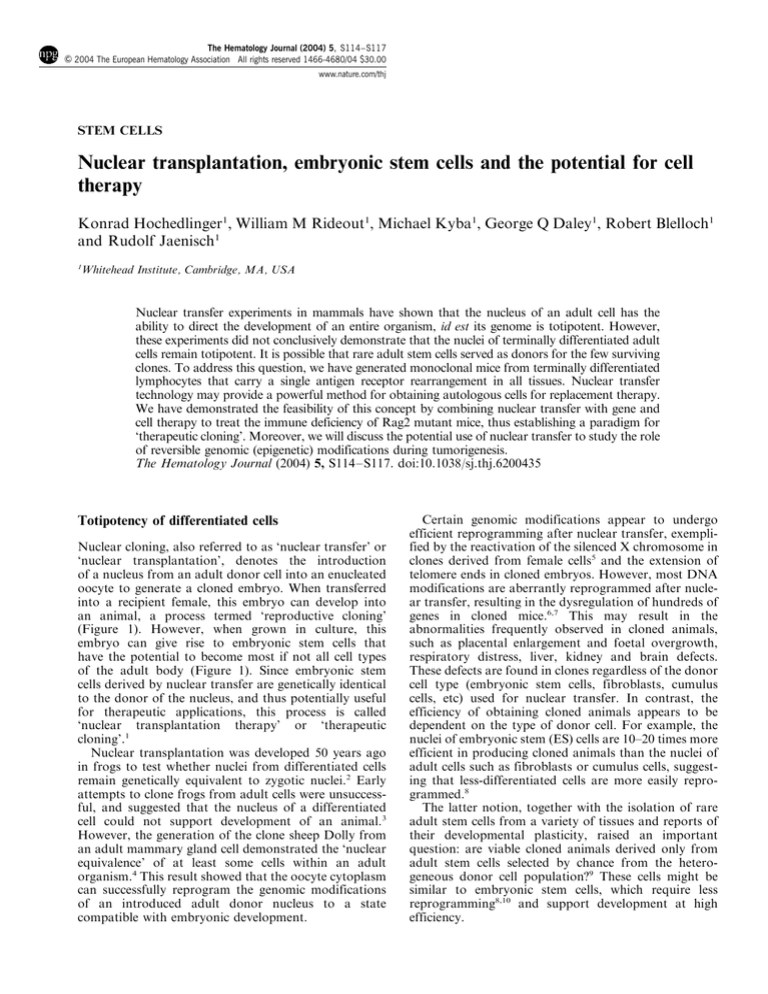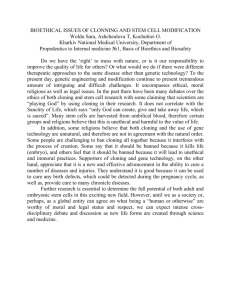
The Hematology Journal (2004) 5, S114–S117
All rights reserved 1466-4680/04 $30.00
& 2004 The European Hematology Association
www.nature.com/thj
STEM CELLS
Nuclear transplantation, embryonic stem cells and the potential for cell
therapy
Konrad Hochedlinger1, William M Rideout1, Michael Kyba1, George Q Daley1, Robert Blelloch1
and Rudolf Jaenisch1
1
Whitehead Institute, Cambridge, MA, USA
Nuclear transfer experiments in mammals have shown that the nucleus of an adult cell has the
ability to direct the development of an entire organism, id est its genome is totipotent. However,
these experiments did not conclusively demonstrate that the nuclei of terminally differentiated adult
cells remain totipotent. It is possible that rare adult stem cells served as donors for the few surviving
clones. To address this question, we have generated monoclonal mice from terminally differentiated
lymphocytes that carry a single antigen receptor rearrangement in all tissues. Nuclear transfer
technology may provide a powerful method for obtaining autologous cells for replacement therapy.
We have demonstrated the feasibility of this concept by combining nuclear transfer with gene and
cell therapy to treat the immune deficiency of Rag2 mutant mice, thus establishing a paradigm for
‘therapeutic cloning’. Moreover, we will discuss the potential use of nuclear transfer to study the role
of reversible genomic (epigenetic) modifications during tumorigenesis.
The Hematology Journal (2004) 5, S114–S117. doi:10.1038/sj.thj.6200435
Totipotency of differentiated cells
Nuclear cloning, also referred to as ‘nuclear transfer’ or
‘nuclear transplantation’, denotes the introduction
of a nucleus from an adult donor cell into an enucleated
oocyte to generate a cloned embryo. When transferred
into a recipient female, this embryo can develop into
an animal, a process termed ‘reproductive cloning’
(Figure 1). However, when grown in culture, this
embryo can give rise to embryonic stem cells that
have the potential to become most if not all cell types
of the adult body (Figure 1). Since embryonic stem
cells derived by nuclear transfer are genetically identical
to the donor of the nucleus, and thus potentially useful
for therapeutic applications, this process is called
‘nuclear transplantation therapy’ or ‘therapeutic
cloning’.1
Nuclear transplantation was developed 50 years ago
in frogs to test whether nuclei from differentiated cells
remain genetically equivalent to zygotic nuclei.2 Early
attempts to clone frogs from adult cells were unsuccessful, and suggested that the nucleus of a differentiated
cell could not support development of an animal.3
However, the generation of the clone sheep Dolly from
an adult mammary gland cell demonstrated the ‘nuclear
equivalence’ of at least some cells within an adult
organism.4 This result showed that the oocyte cytoplasm
can successfully reprogram the genomic modifications
of an introduced adult donor nucleus to a state
compatible with embryonic development.
Certain genomic modifications appear to undergo
efficient reprogramming after nuclear transfer, exemplified by the reactivation of the silenced X chromosome in
clones derived from female cells5 and the extension of
telomere ends in cloned embryos. However, most DNA
modifications are aberrantly reprogrammed after nuclear transfer, resulting in the dysregulation of hundreds of
genes in cloned mice.6,7 This may result in the
abnormalities frequently observed in cloned animals,
such as placental enlargement and foetal overgrowth,
respiratory distress, liver, kidney and brain defects.
These defects are found in clones regardless of the donor
cell type (embryonic stem cells, fibroblasts, cumulus
cells, etc) used for nuclear transfer. In contrast, the
efficiency of obtaining cloned animals appears to be
dependent on the type of donor cell. For example, the
nuclei of embryonic stem (ES) cells are 10–20 times more
efficient in producing cloned animals than the nuclei of
adult cells such as fibroblasts or cumulus cells, suggesting that less-differentiated cells are more easily reprogrammed.8
The latter notion, together with the isolation of rare
adult stem cells from a variety of tissues and reports of
their developmental plasticity, raised an important
question: are viable cloned animals derived only from
adult stem cells selected by chance from the heterogeneous donor cell population?9 These cells might be
similar to embryonic stem cells, which require less
reprogramming8,10 and support development at high
efficiency.
Nuclear transplantation
K Hochedlinger et al
S115
Figure 1 Comparison of normal development with reproductive
cloning and therapeutic cloning. During normal development (left), a
haploid (1n) sperm cell fertilizes a haploid oocyte to form a diploid
(2n) zygote that undergoes cleavage to become a blastocyststage embryo. Blastocysts implant in the uterus and ultimately give
rise to a newborn animal. During reproductive cloning (centre),
the diploid nucleus of an adult donor cell is introduced into an
enucleated oocyte recipient which, after artificial activation, divides
into a cloned blastocyst. Upon transfer into surrogate mothers, a
few of the cloned blastocysts will give rise to a newborn clone. In
contrast, therapeutic cloning (right) requires growing cloned blastocysts in culture to derive an embryonic stem cell line that can be
differentiated in vitro into potentially any cell type of the body required
for therapeutic purposes.
Monoclonal mice generated from terminally
differentiated B- and T-cell nuclei
To prove that the nucleus of a terminally differentiated
cell can be reprogrammed by nuclear transplantation,
we used nuclei with a stable genetic marker that, in
retrospect, enabled the unequivocal identification of
the donor cell that gave rise to the clone. Using mature
lymphocytes and their differentiation-specific immune
receptor rearrangements as a genetic marker, we
showed that fertile adult mice can be generated from
terminally differentiated cells.11 Animals were produced
in a modified two-step cloning procedure: ES cells
were first isolated from cloned blastocysts and then
injected into tetraploid host blastocysts to generate
cloned mice. In this approach, mice are derived entirely
from the injected ES cells, whereas the placenta
is derived from the tetraploid host cells (generated
by electrofusion of a normal fertlilized two-cell
embryo). Monoclonal mice produced from B or T cells
carried
the
genomic
rearrangement
of
the
donor lymphocyte in every tissue. This was shown by
Southern blot analyses using probes that detect
the rearrangement-specific deletions at the immunoglobulin and T-cell receptor loci as well as by DNA
sequencing of the respective rearrangements (Figure 2).
These experiments demonstrated unequivocally that the
nucleus of a fully differentiated cell can be reprogrammed to a totipotent state.
Figure 2 Monoclonal mice can be generated from mature lymphocytes by nuclear transfer. (a, b) Southern blot analyses showing the
absence of unrearranged germline (GL) bands in ES cells and mice
derived from (a) a B-cell nucleus or (b) a T-cell nucleus. This is
indicative of genomic rearrangements at the immunoglobulin heavy
chain (IgH) and T cell receptor alpha (TCR-alpha) locus, respectively.
Probes recognize genomic regions upstream of the J clusters that are
deleted by the rearrangement process. ‘C’ indicates the control bands
detecting genomic regions downstream in the IgH or TCR-alpha loci
that did not undergo DNA rearrangements. (c–f) Sequences of some of
the regions that underwent rearrangements such as the IgH locus (c),
the two light chain loci (d, e) of the B-cell clone and the TCR-beta
locus (f) of the T-cell clone. Rearrangement-specific V, (d), and J
elements are indicated, asterisks mark nucleotides that had been
inserted during the rearrangement process (P/N nucleotides). (WT-ES:
wild-type ES cells; B-ES: ES cells derived from a B-cell nucleus; T-ES:
ES cells derived from a T-cell nucleus. Figure adapted and reprinted
from Hochedlinger and Jaenisch11 by kind permission of Nature
Publication Group, London, UK.).
Cloning efficiency is extremely poor with terminally
differentiated cells
To obtain cloned mice from lymphocytes, we had to use
a modified two-step procedure that involved the
explantation of cloned embryos and the isolation of
ES cells. Notably, no laboratory has yet succeeded in
generating adult mice by directly transferring embryos
cloned from lymphocytes into recipient females. These
observations suggest that reactivation of embryonic
genes in explanted cloned blastocysts might be under
fewer time constraints than cloned blastocysts transferred directly to recipient females. Alternatively, the
culturing process of the explanted blastocysts might
select for those few cells within the embryo that have
undergone successful reprogramming.
The generation of cloned mice from mature lymphocytes established that the nuclei of terminally differentiated cells remain totipotent. However, cloning
from lymphocytes remained extremely inefficient. The
The Hematology Journal
Nuclear transplantation
K Hochedlinger et al
S116
number of cloned embryos that developed to the
blastocyst stage was about ten times lower (4%) as
compared to cloned embryos derived from more
heterogeneous adult cell populations such as fibroblasts
or cumulus cells (30–70%).12 This suggested that adult
cells other than fully differentiated cells are the nuclei
donors in most if not all successful nuclear transfer
experiments. It is therefore possible that many cloned
animals generated by the ‘traditional’ cloning procedure
are in fact derived from the nuclei of adult stem cells or
progenitor cells and not from the nuclei of terminally
differentiated cells. The use of purified adult stem cells,
such as haematopoietic or neural stem cells, as donors in
nuclear transfer experiments will clarify whether these
cells are indeed more amenable to reprogramming than
heterogeneous adult cell populations. The identification
of the most efficient donor cell type for nuclear transfer
may also be important for the therapeutic application of
nuclear transfer (therapeutic cloning).
Therapeutic cloning
In addition to its use in studying nuclear changes during
differentiation, nuclear transfer technology has significant therapeutic potential.1 The concept of ‘therapeutic
cloning’ is to generate an autologous embryonic stemcell line from a patient’s cell for subsequent tissue
replacement therapy (Figure 1).
Immune rejection is a frequent complication of
allogeneic organ transplantation due to immunological
incompatibility between donor and recipient. To treat
this ‘host versus graft’ disease, immunosuppressive
drugs are routinely administered to transplant recipients, a treatment with serious side effects. ES cells
derived by nuclear transplantation are genetically
identical to the patient’s cells, thus eliminating the risk
of immune rejection and the requirement for immunosuppression. Moreover, ES cells provide a renewable
source of tissue for replacement, allowing repeated
therapy when necessary.
Generation of a mouse model for therapeutic cloning
In an attempt to establish a mouse model of therapeutic
cloning, we have combined nuclear cloning with gene
and cell therapy to treat a genetic disorder.13 Specifically, we chose the well characterized Rag2 mutant
mouse that suffers from severe combined immune
deficiency (SCID), a disease resembling human Omenn’s
syndrome. These mice are devoid of mature B and T
cells due to a mutation in the recombination activating
gene 2 (Rag2), which catalyses immune receptor
rearrangements in lymphocytes.
In a first step, we isolated somatic donor cells
(fibroblasts) from the tails of Rag2-deficient mice
and injected their nuclei into enucleated oocytes
(Figure 3). The resultant embryos were cultured to the
blastocyst stage and autologous ES cells were isolated.
Subsequently, one of the mutant Rag2 alleles was
The Hematology Journal
Figure 3 Mouse model of ‘therapeutic cloning’. Tail-tip cells
(fibroblasts) from Rag2-deficient animals were used as donors for
nuclear transfer. Cloned embryos were cultured to the blastocyst stage
to derive autologous embryonic stem cells. Following repair of one of
the mutant Rag2 alleles by homologous recombination, embryonic
stem cells were differentiated into embryoid bodies (embryo-like
structures that contain various somatic cell types) and infected with a
retrovirus expressing the homeodomain transcription factor HoxB4.
Resultant haematopoietic stem cells were expanded and injected
intravenously into irradiated Rag2-deficient animals to reconstitute
their immune system. (Figure adapted and reprinted from Rideout
et al13 by kind permission of Cell Press, Cambridge, MA, USA.).
targeted by homologous recombination in ES cells;
we selected for ES cells that had successfully replaced
one of the defective alleles with a repair construct, thus
restoring normal gene structure to the Rag2 locus. To
obtain the particular somatic cell type required for the
treatment of Rag2 /
mice, these ES cells were
differentiated into ‘embryoid bodies’ and further into
haematopoietic precursors. To further expand these
precursors, we infected cells with a retrovirus expressing
the homeodomain transcription factor HoxB4 that has
been shown to enhance self-renewal of haematopoietic
stem cells. Resulting cells were shown by FACS analysis
to express markers of haematopoietic stem cells and
were transplanted into irradiated Rag2-deficient animals
to treat the disease.
Initial attempts to engraft these cells were, however,
unsuccessful due to an increased level of natural killer
(NK) cells in the Rag2 mutant hosts. ES cell-derived
haematopoietic cells express low levels of the major
histocompatibility complex I (MHC-I) molecule and are
thus preferred targets for NK-mediated destruction. This
type of rejection is different from the classical host-versusgraft disease that is seen in allogeneic organ transplantation and thus specific to the Rag2 mutant mouse model.
Elimination of NK cells by antibody depletion or genetic
ablation enabled the ES cells to efficiently populate the
myeloid and, to a lesser degree, the lymphoid lineages.
Functional B and T cells, which had undergone proper
rearrangements of their immunoglobulin and T-cell
receptor alleles as well as serum immunoglobulins, were
detected in the transplanted mutants.13
This experiment was the first to demonstrate that
nuclear transfer can be combined with gene therapy to
Nuclear transplantation
K Hochedlinger et al
S117
treat a genetic disorder. Consequently, therapeutic cloning should be applicable to other diseases of which the
genetic lesion is known, for example, sickle cell anaemia
or b-thalassemia. Importantly, recent results have shown
that human embryonic stem cells can be generated by
nuclear transfer from adult cells thus demonstrating the
feasibility of ‘therapeutic cloning’ in humans.14
Reprogramming of the cancer genome by nuclear
transfer?
Accumulating evidence shows that tumor formation is
accompanied by both epigenetic and genetic alterations
of the genome.15–17 Unlike genetic changes, epigenetic
changes do not alter the primary DNA sequence and are
therefore reversible. Examples of such epigenetic modifications are the methylation of DNA and histones, the
acetylation/deacetylation of histones, and the packing of
chromatin into euchromatic and heterochromatic regions.18 Epigenetic modifications play an important role
during normal development by regulating gene expression through stable activation or silencing of differentiation-associated genes. Similarly, epigenetic changes can
promote cell proliferation, inhibit apoptosis, and induce
angiogenesis during tumorigenesis by activating onco-
genes and silencing tumor suppressor genes.16,17 For
example, the p16 and VHL tumor suppressor genes are
frequently silenced in human cancer by methylation of
their promoter regions.15 Moreover, the treatment of
tumor cells with methylation and histone modifying
drugs can inhibit malignancy and this inhibition
correlates with the reactivation of important tumor
suppressor loci.15
Nuclear transplantation of lymphocytes has demonstrated that the epigenetic modifications associated with
differentiation can be reprogrammed following nuclear
transfer while the irreversible genomic rearrangements
were retained in cloned animals.11 Thus, nuclear transfer
provides a tool to reprogram selectively the epigenetic
component of a cancer cell genome to study its effect on
development and tumorigenesis.
To that end, we have performed nuclear transfer of
different tumor cells to derive embryonic stem cells that
were then used to assay their developmental and
tumorigenic potential. Preliminary results indicate that
cells from different embryonic carcinomas and those
from a RAS-inducible melanoma model can be reprogrammed into embryonic stem cells. However, the
developmental and tumorigenic potential of these
embryonic stem cell lines in chimeric animals appears
to be very different for the two types of tumors.
References
1 Hochedlinger K, Jaenisch R. Nuclear transplantation,
embryonic stem cells, and the potential for cell therapy.
N Engl J Med 2003.
2 Hochedlinger K, Jaenisch R. Nuclear transplantation:
lessons from frogs and mice. Curr Opin Cell Biol 2002;
14: 741–748.
3 DiBerardino M. Genetic stability and modulation of
metazoan nuclei transplanted into eggs and oocytes.
Differentiation 1980; 17: 17–30.
4 Wilmut I, Schnieke AE, McWhir J, Kind AJ, Campbell
KH. Viable offspring derived from fetal and adult
mammalian cells. Nature 1997; 385: 810–813.
5 Eggan K, Akutsu H, Hochedlinger K, Rideout III W,
Yanagimachi R, Jaenisch R. X-chromosome inactivation
in cloned mouse embryos. Science 2000; 290: 1578–1581.
6 Humpherys D, Eggan K, Akutsu H, Hochedlinger K,
Rideout III WM, Biniszkiewicz D et al. Epigenetic
instability in ES cells and cloned mice. Science 2001; 293:
95–97.
7 Humpherys D, Eggan K, Akutsu H, Friedman A,
Hochedlinger K, Yanagimachi R et al. Abnormal gene
expression in cloned mice derived from embryonic stem cell
and cumulus cell nuclei. Proc Natl Acad Sci USA 2002; 99:
12889–12894.
8 Rideout III WM, Eggan K, Jaenisch R. Nuclear cloning
and epigenetic reprogramming of the genome. Science
2001; 293: 1093–1098.
9 Liu L. Cloning efficiency and differentiation. Nat Biotechnol 2001; 19: 406.
10 Rideout WM, Wakayama T, Wutz A, Eggan K, JacksonGrusby L, Dausman J et al. Generation of mice from wildtype and targeted ES cells by nuclear cloning. Nat Genet
2000; 24: 109–110.
11 Hochedlinger K, Jaenisch R. Monoclonal mice generated
by nuclear transfer from mature B and T donor cells.
Nature 2002; 415: 1035–1038.
12 Wakayama T, Tabar V, Rodriguez I, Perry AC, Studer L,
Mombaerts P. Differentiation of embryonic stem cell lines
generated from adult somatic cells by nuclear transfer.
Science 2001; 292: 740–743.
13 Rideout WM, Hochedlinger K, Kyba M, Daley GQ,
Jaenisch R. Correction of a genetic defect by nuclear
transplantation and combined cell and gene therapy. Cell
2002; 109: 17–27.
14 Hwang WS, Ryu YJ, Park JH, Park ES, Lee EG,
Koo JM et al. Evidence of a pluripotent human embryonic
stem cell line derived from a cloned blastocyst. Science
2004; 303 (5664): 1669–1674.
15 Jones PA, Baylin SB. The fundamental role of
epigenetic events in cancer. Nat Rev Genet 2002; 3:
415–428.
16 Felsher DW. Cancer revoked: oncogenes as therapeutic
targets. Nat Rev Cancer 2003; 3: 375–380.
17 Hahn WC, Weinberg RA. Rules for making human tumor
cells. N Engl J Med 2002; 347: 1593–1603.
18 Li E. Chromatin modification and epigenetic reprogramming in mammalian development. Nat Rev Genet 2002; 3:
662–673.
The Hematology Journal





